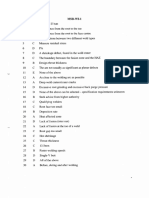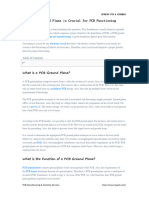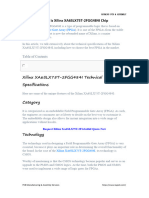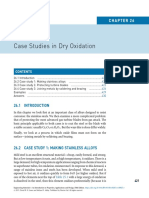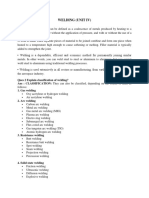What Is The Cause of Insufficient Solder
What Is The Cause of Insufficient Solder
Uploaded by
jackCopyright:
Available Formats
What Is The Cause of Insufficient Solder
What Is The Cause of Insufficient Solder
Uploaded by
jackOriginal Description:
Original Title
Copyright
Available Formats
Share this document
Did you find this document useful?
Is this content inappropriate?
Copyright:
Available Formats
What Is The Cause of Insufficient Solder
What Is The Cause of Insufficient Solder
Uploaded by
jackCopyright:
Available Formats
RAYMING PCB & ASSEMBLY
What is the cause of insufficient solder?
Soldering is a critical process used to mechanically and electrically join
components in electronic assemblies. Insufficient solder can lead to poor
quality solder joints that are unreliable both electrically and mechanically.
There are several potential causes that can result in insufficient solder
during the soldering process:
Table of Contents
Poor Solderability of Parts
The solderability refers to how well the parts to be soldered can wet and
adhere to solder. Following factors affect solderability:
Oxidation or Contamination
Metal surfaces like component leads and PCB pads get oxidized
over time
This makes solder wetting difficult resulting in poor joints
Oil, grease or other residues also reduce solderability
Incompatible Materials
Certain metals like stainless steel and aluminum do not solder well
Lead-free solders have worse solderability than leaded solders
PCB Manufacturing & Assembly Services https://www.raypcb.com/
RAYMING PCB & ASSEMBLY
Mismatch between surfaces and solder alloy reduces wetting
Old Components
Components stored for long periods have degraded solderability
Moisture absorption also reduces solderability of parts
Lack of Solder Coating
Components without pre-applied solder coating have poorer
solderability
Coatings like hot solder dip, ENIG, immersion tin improve wetting
Thermal Damage
Overheating parts during soldering destroys solderability
Burnt or charred surfaces will not accept solder properly
Proper handling, storage and pretinning along with protective coatings is
needed to ensure good solderability of parts.
Request PCB Manufacturing & Assembly Quote Now
Low Soldering Temperature
PCB Manufacturing & Assembly Services https://www.raypcb.com/
RAYMING PCB & ASSEMBLY
Sufficient temperature is essential for proper melting and wetting of
solder. Insufficient temperature causes:
Solder joint is formed before flux can properly activate and remove
surface oxides
Solder does not become fully molten and evenly flow over the joint
surfaces
Partial wetting occurs resulting in weak joints with cold solder spots
Common reasons for low soldering temperature:
Soldering iron tip is not properly tinned or maintained
Low iron power rating or large tip being used
Poor contact between iron tip and joint being soldered
Excessive heat sinking in large ground planes and leads
Fast motion of iron tip does not allow time for heating
PCB Manufacturing & Assembly Services https://www.raypcb.com/
RAYMING PCB & ASSEMBLY
Using adequate tip size, power rating, contact time/motion and re-tinning
maintenance helps avoid low temperatures.
Problems with Solder Paste Deposition
For reflow soldering, insufficient solder paste deposit will lead to poor
joints. Some contributing factors are:
Excessive gap between component and PCB pad
Misalignment of paste deposits with pads
Too little paste dispensed due to volume setting issues
Clogging or leaks in solder paste stencil
Outgassing and drying of the paste deposit before reflow
Slumping of paste due to high ambient temperatures
Good process controls, stencil cleaning, monitoring of paste deposits and
proper storage helps avoid these issues.
Defects in PCB and Component
PCB and component defects that absorb solder and restrict flow result in
insufficient solder:
PCB Defects
Voids in ground or thermal planes acting as heat sinks
Poor pad design with insufficient wetting area
PCB Manufacturing & Assembly Services https://www.raypcb.com/
RAYMING PCB & ASSEMBLY
Contamination like oils and residues on pads
Component Defects
Cross-talk barriers blocking flow between leads
Tight lead spacing preventing access to solder
Warped leads or gaps between lead and PCB pad
Inspecting PCBs and components and checking pad dimensions ensures
such issues are avoided.
Inadequate Flux
Flux removes surface oxides enabling solder flow and wetting. Following
flux related reasons reduce soldering effectiveness:
Too little flux applied to joint
Flux drying out before completing soldering
Weak or water-soluble flux that is too mild
Low activity of aged flux reducing cleaning capability
Baked on or burnt flux residues interfering with wetting
Adequate amount of appropriate rosin-based flux should be applied to
maintain solderability.
Problems with Solder Wire
PCB Manufacturing & Assembly Services https://www.raypcb.com/
RAYMING PCB & ASSEMBLY
Issues with solder wire composition and condition also affect soldering:
Impurities and voids in solder wire reducing fluidity -Insufficient
wire diameter to thermal mass of joint
Oxidation or contamination of solder wire surface
Mismatch between alloy melting point and process temperature
Low tin-lead percentage of alloy increasing melting point
Proper solder wire handling and selection compatible with process
requirements avoids these problems.
Other Process Issues
Excessive heat sinking due to large ground planes
Jigging misalignment resulting in loss of contact between tipped
iron and joint
PCB Manufacturing & Assembly Services https://www.raypcb.com/
RAYMING PCB & ASSEMBLY
Soldering for too short a duration to allow adequate heating
Vibration or movement disturbing solder bead formation
Poor fume extraction exposing joints to corrosive flux residues
Control and monitoring of process parameters is needed to counteract
these effects.
Troubleshooting Insufficient Solder
Visually inspect joint closely under magnification to identify poor
wetting, cold spots etc.
Use solderability testing chemicals like rosin that react when applied
to oxidized/contaminated areas
Thermally profile temperatures at joint during soldering to check if
adequate temperature is reached
Review process parameters like heat application duration, wire
gauge, tip size etc.
Evaluate PCB design – thermal planes, pad dimensions, spacing etc.
Test flux activity and assess paste condition
Check for issues with solder bath contamination or dross buildup
if wave soldering
Preventing Insufficient Solder
PCB Manufacturing & Assembly Services https://www.raypcb.com/
RAYMING PCB & ASSEMBLY
Use proper storage and handling of components to maintain
solderability
Apply solderability preservatives like benzotriazole on surfaces
Ensure PCB and component cleanliness before soldering
Select the right solder alloy matched to process temperature
Use adequate flux and apply uniformly to joints
Clean and tin soldering iron tips regularly
Optimize soldering temperature, duration and motion
Inspect stencil condition and paste deposits
Ensure adequate fillet wicking over joint
Monitor the soldering process continuously and make adjustments
as needed
With proper analysis of root causes and preventive steps, issues due to
insufficient solder can be eliminated resulting in reliable, high quality
solder joints.
FAQs
Q1. How can I identify if insufficient solder is causing poor quality joints?
Look closely under magnification for joints with dull finish, grainy
structure, dark spots, non-wetting and dewetting of surfaces indicating
cold solder. Probe joints for continuity issues signalling poor bonding.
PCB Manufacturing & Assembly Services https://www.raypcb.com/
RAYMING PCB & ASSEMBLY
Q2. What is the ideal temperature for hand soldering with lead-tin alloy?
For Sn60Pb40 solder, ideal tip temperature is around 370℃ to 400℃.
Higher temperatures above 450℃ should be avoided to prevent damage
to components.
Q3. How does excess flux cause insufficient solder problems?
Too much flux can actually impede solder flow rather than helping it. It
also leads to charring which deposits residues that hinder wetting. A thin
uniform layer of flux should be applied.
Q4. Can inadequate solder volume be a reason for insufficient solder defects?
Yes, using too little solder wire compared to the thermal mass of the joint
can lead to insufficient solder. Larger wire diameter or longer application
time is required.
Q5. What is the effect of oxidation on solderability?
Metal oxide formation on surfaces interferes with solder wetting by
creating a barrier layer. Flux helps remove oxides but preventing oxidation
via protective coatings or oxidation inhibitors also improves solderability.
Related Posts:
PCB Manufacturing & Assembly Services https://www.raypcb.com/
RAYMING PCB & ASSEMBLY
1. What is the Significance of Solder Mask Defined Pads in Solder Pad
PCBs?
2. How to DIY a smd Stencil for Your PCB Solder
3. What is Solder Paste Stencil
4. What is Solder Paste ?
https://www.raypcb.com/analysis-of-the-causes-of-insufficient-solder-gloss-at-smt-patch/
PCB Manufacturing & Assembly Services https://www.raypcb.com/
You might also like
- Interpretation of J-STD-001 and J-STD-004 Regarding FluxesDocument15 pagesInterpretation of J-STD-001 and J-STD-004 Regarding FluxesCamilo Souza100% (1)
- Tips For Achieving Perfect PCB SolderingDocument21 pagesTips For Achieving Perfect PCB SolderingjackNo ratings yet
- Top Reasons For PCB Pad Cratering in BGA SolderingDocument12 pagesTop Reasons For PCB Pad Cratering in BGA SolderingjackNo ratings yet
- Quality Soldering Balls For Advanced BGA SolutionsDocument4 pagesQuality Soldering Balls For Advanced BGA SolutionsjackNo ratings yet
- What Is A Cold Joint Solder and How Can You Prevent ItDocument13 pagesWhat Is A Cold Joint Solder and How Can You Prevent ItjackNo ratings yet
- How To Prevent The Tombstone During The SMT Reflow ProcessDocument10 pagesHow To Prevent The Tombstone During The SMT Reflow ProcessjackNo ratings yet
- Detection & Prevention of Solder Joint Failure - Rush PCBDocument4 pagesDetection & Prevention of Solder Joint Failure - Rush PCBpeterpetermonNo ratings yet
- Lead-Free SMT Defects How To Prevent ThemDocument9 pagesLead-Free SMT Defects How To Prevent ThemTin NguyenNo ratings yet
- How To Solder The Chip ComponentsDocument19 pagesHow To Solder The Chip ComponentsjackNo ratings yet
- What Is Wave Soldering Temperature Profile A Comprehensive Guide To SolderingDocument13 pagesWhat Is Wave Soldering Temperature Profile A Comprehensive Guide To SolderingjackNo ratings yet
- Ap02014 R1 SolderingDocument7 pagesAp02014 R1 SolderingBernz Apura FernandezNo ratings yet
- Causes of PCB Delamination and How To Repair ThemDocument13 pagesCauses of PCB Delamination and How To Repair ThemjackNo ratings yet
- The Impact of Bent PCB - How To Prevent ItDocument5 pagesThe Impact of Bent PCB - How To Prevent ItjackNo ratings yet
- Weld Defects CswipDocument10 pagesWeld Defects CswipOLiver RobertNo ratings yet
- What Is A Low Temperature Solder PasteDocument10 pagesWhat Is A Low Temperature Solder PastejackNo ratings yet
- What Is Solder PasteDocument14 pagesWhat Is Solder PastejackNo ratings yet
- What Is The Essence of Thermal Relief in A PCBDocument8 pagesWhat Is The Essence of Thermal Relief in A PCBjackNo ratings yet
- How To Minimize Defects by Adjusting The Reflow Profile PDFDocument4 pagesHow To Minimize Defects by Adjusting The Reflow Profile PDFTiffany FergusonNo ratings yet
- Difference Between Cold Welding and Pseudo SolderingDocument12 pagesDifference Between Cold Welding and Pseudo SolderingjackNo ratings yet
- What Are The Different Surface Finishes in PCBDocument25 pagesWhat Are The Different Surface Finishes in PCBjackNo ratings yet
- Heavy Copper PCB Manufacturing and Design GuidelinesDocument15 pagesHeavy Copper PCB Manufacturing and Design GuidelinesjackNo ratings yet
- What Are The Best Practices of PTH SolderingDocument10 pagesWhat Are The Best Practices of PTH SolderingjackNo ratings yet
- Types of PCB and Wave SolderingDocument4 pagesTypes of PCB and Wave Solderingpuranamravinder100% (2)
- Solder Leveled - Hot Air Solder Leveled (HASL)Document2 pagesSolder Leveled - Hot Air Solder Leveled (HASL)СашаМатијашевићNo ratings yet
- 12 Major Causes of Foaming On Copper Plating of The PCB BoardDocument8 pages12 Major Causes of Foaming On Copper Plating of The PCB BoardjackNo ratings yet
- Wave Soldering: Wave Soldering Is A Bulk Soldering Process Used in TheDocument5 pagesWave Soldering: Wave Soldering Is A Bulk Soldering Process Used in TheMadhusudanan Ashok0% (1)
- Welding Defects - ArabweldersDocument63 pagesWelding Defects - ArabweldersKhalid HafezNo ratings yet
- How To Prevent Open Defects and Tombstones During PCB AssemblyDocument5 pagesHow To Prevent Open Defects and Tombstones During PCB AssemblyjackNo ratings yet
- Casting DefectDocument25 pagesCasting Defectravikataria02No ratings yet
- Designing The High Thermal Conductivity Laminates Taconic RF-60TC PCBDocument8 pagesDesigning The High Thermal Conductivity Laminates Taconic RF-60TC PCBjackNo ratings yet
- Welding - Defects and RemediesDocument62 pagesWelding - Defects and RemediesAshish KumarNo ratings yet
- Welding - Defects and RemediesDocument62 pagesWelding - Defects and RemediesAshish KumarNo ratings yet
- What Is Solder Skip On A PCB BoardDocument7 pagesWhat Is Solder Skip On A PCB BoardjackNo ratings yet
- Weld DefectsDocument48 pagesWeld DefectsStewart StevenNo ratings yet
- Hot Solder Dip Prevents RustDocument4 pagesHot Solder Dip Prevents RustDaoud MiourighNo ratings yet
- Lead Free Solder Vs Lead Solder Which Is BetterDocument11 pagesLead Free Solder Vs Lead Solder Which Is BetterjackNo ratings yet
- What Is Shengyi SAR10S PCBDocument4 pagesWhat Is Shengyi SAR10S PCBjackNo ratings yet
- Cookson Electronics Assembly Materials Lead-Free Seminar Pad Finishes, Laminates and Component FinishesDocument12 pagesCookson Electronics Assembly Materials Lead-Free Seminar Pad Finishes, Laminates and Component FinishesRichie ReyesNo ratings yet
- How To Control Bow and Twist in PCBDocument16 pagesHow To Control Bow and Twist in PCBjackNo ratings yet
- Nepcon: Smart GROUPDocument6 pagesNepcon: Smart GROUPanandsharma9No ratings yet
- UMW SMTA Surface Finish JuneDocument56 pagesUMW SMTA Surface Finish JuneZian HennNo ratings yet
- Defects in CastingDocument29 pagesDefects in CastingbhimsignNo ratings yet
- CSWIP Answers NewDocument9 pagesCSWIP Answers NewHossam EssawyNo ratings yet
- Esab - Solid Wire & Rod - SWR-10000Document14 pagesEsab - Solid Wire & Rod - SWR-10000Carlos PadillaNo ratings yet
- لحیم و اشکالات کستینگDocument43 pagesلحیم و اشکالات کستینگvatankhahpooyaNo ratings yet
- Welding Defects Method of Controlling Welding DefectsDocument21 pagesWelding Defects Method of Controlling Welding DefectsPrashant Handa100% (1)
- SMT TsDocument38 pagesSMT TsGlauber AquinoNo ratings yet
- What Is Lifted Pad and Issues On Printed Circuit BoardsDocument10 pagesWhat Is Lifted Pad and Issues On Printed Circuit BoardsjackNo ratings yet
- Unit V: Design of Weld Joints, Weldability and Testing of WeldmentsDocument24 pagesUnit V: Design of Weld Joints, Weldability and Testing of WeldmentsparthibankNo ratings yet
- 11 SolderingDocument11 pages11 SolderingrameshNo ratings yet
- Stencil Design For Mixed Technology through-holeSMDocument8 pagesStencil Design For Mixed Technology through-holeSMRobert MartosNo ratings yet
- Exploring The Contrasts Between ENIG vs. HASLDocument19 pagesExploring The Contrasts Between ENIG vs. HASLjackNo ratings yet
- Welding WeldingDocument10 pagesWelding WeldingaakankshaNo ratings yet
- Successful Pin BrazingDocument2 pagesSuccessful Pin BrazingGlennSymingtonNo ratings yet
- ISO 5817 Weld Defects AnalysisDocument82 pagesISO 5817 Weld Defects Analysisaravindan50% (2)
- Understanding Bow and Twist On A PCBDocument12 pagesUnderstanding Bow and Twist On A PCBjackNo ratings yet
- Introduction To Welding Technology: The WeldnetDocument67 pagesIntroduction To Welding Technology: The Weldnetlamia97No ratings yet
- Welding Terminology: A Guide to MIG, TIG, Stick, Gas, and Spot Welding TermsFrom EverandWelding Terminology: A Guide to MIG, TIG, Stick, Gas, and Spot Welding TermsNo ratings yet
- The Art of Lead Burning: A practical treatise explaining the apparatus and processesFrom EverandThe Art of Lead Burning: A practical treatise explaining the apparatus and processesNo ratings yet
- Soldering Electronic Components 2nd EditionFrom EverandSoldering Electronic Components 2nd EditionRating: 3 out of 5 stars3/5 (2)
- Why You Should Choose The Shengyi S7439G PCB MaterialDocument5 pagesWhy You Should Choose The Shengyi S7439G PCB MaterialjackNo ratings yet
- Xilinx XAZU2EG-1SBVA484I Fpga ApplicationDocument5 pagesXilinx XAZU2EG-1SBVA484I Fpga ApplicationjackNo ratings yet
- Why OEM Circuit Boards Are Ideal For Use in Several ApplicationsDocument6 pagesWhy OEM Circuit Boards Are Ideal For Use in Several ApplicationsjackNo ratings yet
- Where To Buy Rogers RT Duroid 5880 LaminateDocument5 pagesWhere To Buy Rogers RT Duroid 5880 LaminatejackNo ratings yet
- Why The Arlon 49N PCB Material Is Useful in High Temperature or High Performance ApplicationsDocument4 pagesWhy The Arlon 49N PCB Material Is Useful in High Temperature or High Performance ApplicationsjackNo ratings yet
- Why A PCB Ground Plane Is Crucial For PCB FunctioningDocument3 pagesWhy A PCB Ground Plane Is Crucial For PCB FunctioningjackNo ratings yet
- Why Is The Panasonic R-F705S Useful For Mobile and Automotive ProductsDocument4 pagesWhy Is The Panasonic R-F705S Useful For Mobile and Automotive ProductsjackNo ratings yet
- Why Non Recurring Engineering Cost (NRE Charge) Is Important For Your PCBDocument4 pagesWhy Non Recurring Engineering Cost (NRE Charge) Is Important For Your PCBjackNo ratings yet
- Why 3D Print PCBs Matter in Today's Electronics ProductionDocument4 pagesWhy 3D Print PCBs Matter in Today's Electronics ProductionjackNo ratings yet
- Why Is The Home Energy Monitor ImportantDocument7 pagesWhy Is The Home Energy Monitor ImportantjackNo ratings yet
- Who Are The Leading Electrical Coil ManufacturersDocument5 pagesWho Are The Leading Electrical Coil ManufacturersjackNo ratings yet
- What Is The Significance of ENIG Plating ThicknessDocument4 pagesWhat Is The Significance of ENIG Plating ThicknessjackNo ratings yet
- What Is The Significance of Home Electronics PCBDocument6 pagesWhat Is The Significance of Home Electronics PCBjackNo ratings yet
- What Is Xilinx XA6SLX75T-2FGG484I ChipDocument5 pagesWhat Is Xilinx XA6SLX75T-2FGG484I ChipjackNo ratings yet
- Where Does The QuickLogic Eclipse FPGA Architecture Family Play A RoleDocument11 pagesWhere Does The QuickLogic Eclipse FPGA Architecture Family Play A RolejackNo ratings yet
- What Is The Significance of IOT in AgricultureDocument8 pagesWhat Is The Significance of IOT in AgriculturejackNo ratings yet
- What Is Signal Integrity A Comprehensive OverviewDocument9 pagesWhat Is Signal Integrity A Comprehensive OverviewjackNo ratings yet
- What Is The Melting Point of SolderDocument4 pagesWhat Is The Melting Point of SolderjackNo ratings yet
- What Is The Purpose and Applications of A PCB MotherboardDocument4 pagesWhat Is The Purpose and Applications of A PCB MotherboardjackNo ratings yet
- What Is Xilinx Virtex-5 FPGADocument8 pagesWhat Is Xilinx Virtex-5 FPGAjackNo ratings yet
- What Is Xilinx Spartan-7 Its Datasheet and Reference DesignsDocument20 pagesWhat Is Xilinx Spartan-7 Its Datasheet and Reference DesignsjackNo ratings yet
- What Is Taconic TSM-DS3b PCBDocument7 pagesWhat Is Taconic TSM-DS3b PCBjackNo ratings yet
- What Is The Difference Between ARM and FPGA ProcessorsDocument9 pagesWhat Is The Difference Between ARM and FPGA ProcessorsjackNo ratings yet
- What Is Through Hole PCB AssemblyDocument12 pagesWhat Is Through Hole PCB AssemblyjackNo ratings yet
- What Is SMT Soldering Process Step by StepDocument12 pagesWhat Is SMT Soldering Process Step by StepjackNo ratings yet
- What Is Xilinx Kintex UltraScale UltraScale+Document8 pagesWhat Is Xilinx Kintex UltraScale UltraScale+jackNo ratings yet
- What Is The Significance of Azure IoTDocument6 pagesWhat Is The Significance of Azure IoTjackNo ratings yet
- What Is The Difference Between FFC Connector and FPC ConnectorDocument14 pagesWhat Is The Difference Between FFC Connector and FPC ConnectorjackNo ratings yet
- What Is The Difference Between Clean Flux and No Clean Flux Off PCBDocument13 pagesWhat Is The Difference Between Clean Flux and No Clean Flux Off PCBjackNo ratings yet
- What Is Thermal Consideration in PCB DesignDocument6 pagesWhat Is Thermal Consideration in PCB DesignjackNo ratings yet
- Arduino PPT AkhilDocument15 pagesArduino PPT Akhilakhil gharuNo ratings yet
- PCB Surface Finishes Presentation by MultekDocument54 pagesPCB Surface Finishes Presentation by Multeksmtdrkd100% (1)
- 42PFL4007G-78 Service+fonte PDFDocument74 pages42PFL4007G-78 Service+fonte PDFPedro AfonsoNo ratings yet
- 788bs Led MatrixDocument7 pages788bs Led Matrixdreyes2288No ratings yet
- Philips 190TW8FB.00Document90 pagesPhilips 190TW8FB.00kemog100% (1)
- LG 65UF6800-UA Chassis LA5ZYDocument58 pagesLG 65UF6800-UA Chassis LA5ZYJafisson Joanas De AmorimNo ratings yet
- MPR (22446) ManualDocument31 pagesMPR (22446) Manualsiddiquimuzammil876No ratings yet
- Color TV: Service ManualDocument29 pagesColor TV: Service ManualWasantha MunasinghaNo ratings yet
- LG 55uf850t, 850y-Tb 55uf851t, Y-Tc Chassis Lb53h SMDocument101 pagesLG 55uf850t, 850y-Tb 55uf851t, Y-Tc Chassis Lb53h SMLuis Fernando Calle JaramilloNo ratings yet
- How To Solder Like A Pro: Detailed Instruction, Helpful Hints, Safety Tips, and A Comprehensive Troubleshooting GuideDocument21 pagesHow To Solder Like A Pro: Detailed Instruction, Helpful Hints, Safety Tips, and A Comprehensive Troubleshooting Guidesossie100% (10)
- Winstar Display Co., LTD: SpecificationDocument29 pagesWinstar Display Co., LTD: SpecificationcrbsNo ratings yet
- Wh1602b-Tmi-et (LCD Con Backlight)Document30 pagesWh1602b-Tmi-et (LCD Con Backlight)FedericoNo ratings yet
- Welding - Made EasyDocument102 pagesWelding - Made EasyRohan Gupta100% (3)
- IPC Standard ListDocument41 pagesIPC Standard ListcdmingNo ratings yet
- Myths and Beliefs in Modern Electronic Assembly and Soldering TechniquesDocument8 pagesMyths and Beliefs in Modern Electronic Assembly and Soldering TechniquessmtdrkdNo ratings yet
- Building Circuits On BreadboardsDocument23 pagesBuilding Circuits On Breadboardsniyop4allNo ratings yet
- RX-V767/HTR-7063/ RX-A800: Av ReceiverDocument164 pagesRX-V767/HTR-7063/ RX-A800: Av ReceiverJürgen WeberNo ratings yet
- Sony Hcd-rg190 Rg290Document126 pagesSony Hcd-rg190 Rg290Ninguno NingunitoNo ratings yet
- Karnataka Final11Document67 pagesKarnataka Final11vasabakaNo ratings yet
- RohsDocument49 pagesRohssyladrianNo ratings yet
- AlloyDocument15 pagesAlloyansu kaushalNo ratings yet
- Chapter 26 - Case Studies in Dry Oxidation - 2019 - Engineering Materials 1Document10 pagesChapter 26 - Case Studies in Dry Oxidation - 2019 - Engineering Materials 1Bhukya VenkateshNo ratings yet
- LG 32LJ51 LD76HDocument53 pagesLG 32LJ51 LD76HDaniela SantanaNo ratings yet
- Hera CeramDocument60 pagesHera CeramStefan IonelNo ratings yet
- 4.11301200 - Fine Pitch Bumping Formation Application - Semicon Taiwan 2011Document35 pages4.11301200 - Fine Pitch Bumping Formation Application - Semicon Taiwan 2011denghueiNo ratings yet
- Solder Paste Print Inspection Defect GuideDocument44 pagesSolder Paste Print Inspection Defect Guideengenhariatip1No ratings yet
- Welding (Unit Iv)Document19 pagesWelding (Unit Iv)Susheel GuptaNo ratings yet
- Panasonic Sa-Vk480eeDocument163 pagesPanasonic Sa-Vk480eeОлександр МринськийNo ratings yet
- Lg+29ln450b,+450u,+457b,+457u+ch +la31r+led+tvDocument35 pagesLg+29ln450b,+450u,+457b,+457u+ch +la31r+led+tvСтоян ДимитровNo ratings yet










































